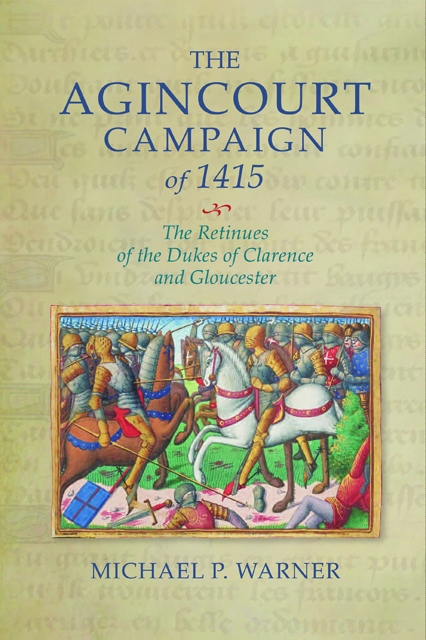Book contents
- Frontmatter
- Contents
- Lists of Tables and Charts
- List of Figures
- Acknowledgements
- Abbreviations
- Introduction
- 1 Before the Campaign
- 2 The Muster Rolls of the 1415 Expedition
- 3 Clarence’s and Gloucester’s 1415 Retinues
- 4 The Sub-Retinue Captains
- 5 During the Campaign
- 6 After the Campaign
- Conclusion
- Appendices
- Bibliography
- Index
- Warfare in History
2 - The Muster Rolls of the 1415 Expedition
Published online by Cambridge University Press: 14 January 2023
- Frontmatter
- Contents
- Lists of Tables and Charts
- List of Figures
- Acknowledgements
- Abbreviations
- Introduction
- 1 Before the Campaign
- 2 The Muster Rolls of the 1415 Expedition
- 3 Clarence’s and Gloucester’s 1415 Retinues
- 4 The Sub-Retinue Captains
- 5 During the Campaign
- 6 After the Campaign
- Conclusion
- Appendices
- Bibliography
- Index
- Warfare in History
Summary
The muster was an essential stage in the lifecycle of a late English medieval army. Yet, no contemporary description survives of how a muster was undertaken. Likewise, while the muster rolls associated with the 1415 expedition have been thoroughly utilised by Curry and other historians, as the Medieval Soldier Database stands as testament to, comparatively less focus has been given to considering how the process that led to their creation worked. Focusing specifically on the 1415 muster rolls, this chapter explores what happened before the muster, then during it, and finally what happened afterwards. Particular attention is paid to the complete muster rolls associated with the retinues commanded by the dukes of Clarence and Gloucester, although all the surviving 1415 muster rolls are considered.
In order to achieve this, the chapter focuses on a number of key issues. These include the possibility that captains submitted lists of the men they expected to arrive before the muster, the layout and format of the rolls, terminology used, membrane crossover, blank spaces in lists, pointing of names, number of hands, annotations, insertions, indenting, joining of membranes, likelihood of a second muster during the campaign and the fate of the rolls after the muster. This systematic and structured approach will help increase our understanding of the recruitment of the army, the process and mechanics of the muster, and how the rolls we see today in The National Archives were created.
The 1415 expedition is well served by surviving muster rolls, especially compared to the first decade of the fifteenth century where there is aparticular drought of such documents. A total of 10 muster rolls survive for the 1415 expedition. Although this chapter is primarily concerned with the 1415 muster rolls, to fully understand their position within the administration of the 1415 army a range of additional sources are explained and explored. These include indentures, sub-indentures, warrants for issue, issue rolls, post-campaign accounts and retinue rolls. It must be stressed that in this chapter we are specifically concerned with the muster rolls, created shortly before embarkation, rather than the retinue rolls that were submitted as part of the post-campaign accounting process after the army had returned to England. The retinue rolls are likewise an incredibly useful source for nominal study, worthy of consideration in their own right. Indeed, there are many more retinue rolls surviving for the 1415 campaign than there are muster rolls.
- Type
- Chapter
- Information
- The Agincourt Campaign of 1415The Retinues of the Dukes of Clarence and Gloucester, pp. 31 - 70Publisher: Boydell & BrewerPrint publication year: 2021



